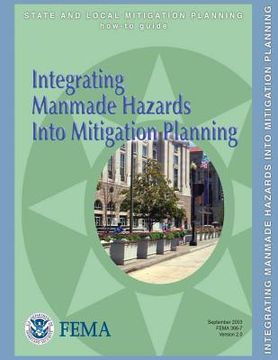Integrating Manmade Hazards Into Mitigation Planning (State and Local Mitigation Planning How-To Guide; FEMA 386-7 / Version 2.0 / September 2003) (en Inglés)
Reseña del libro "Integrating Manmade Hazards Into Mitigation Planning (State and Local Mitigation Planning How-To Guide; FEMA 386-7 / Version 2.0 / September 2003) (en Inglés)"
The Federal Emergency Management Agency (FEMA) has developed this series of mitigation planning "how-to" guides to assist states, communities, and tribes in enhancing their hazard mitigation planning capabilities. These guides are designed to provide the type of information state and local governments need to initiate and maintain a planning process that will result in safer communities. These guides are applicable to states and communities of various sizes and varying ranges of financial and technical resources. This how-to series is not intended to be the last word on any of the subject matter covered; rather, it is meant to provide clear guidance for the field practitioner. In practice, these guides may be supplemented with more extensive technical resources and the use of experts when necessary. The series consists of four guides covering the core aspects of the planning process, and additional guides addressing special topics in hazard mitigation. The "core four" guides cover: Getting started with the mitigation planning process, including important considerations for how you can organize your efforts to develop an effective mitigation plan (FEMA 386-1); Identifying hazards and assessing losses to your community or state (FEMA 386-2); Setting mitigation priorities and goals for your community or state and writing the plan (FEMA 386-3); and Implementing the mitigation plan, including project funding and maintaining a dynamic plan that changes to meet new developments (FEMA 386-4). Special topics covered include: Evaluating potential mitigation actions through the use of benefit-cost analysis and other techniques (FEMA 386-5); Incorporating special considerations into hazard mitigation planning for historic properties and cultural resources (FEMA 386-6); Incorporating mitigation considerations for manmade hazards into hazard mitigation planning, the topic of this how-to guide (FEMA 386-7); Using multi-jurisdictional approaches to mitigation planning (FEMA 386-8); and Finding and securing technical and financial resources for mitigation planning (FEMA 386-9). Disasters are events that can cause loss of life and property, environmental damage, and disruption of governmental, social, and economic activities. They occur when hazards impact human settlements and the built environment. Throughout the Cold War, the focus of emergency management planning was on responding to and recovering from nuclear attack by foreign enemies. During the 1990s, this emphasis shifted to address natural disasters such as hurricanes, earthquakes, tornadoes, and floods. Yet again, the need to incorporate new threats into emergency management planning-this time, manmade hazards such as terrorism and technological disasters-has become all too apparent, as demonstrated by the September 11, 2001 attacks on New York City and Washington, DC and the July 2001 hazardous material train derailment and fire in Baltimore, Maryland. Additionally, the 2001 anthrax attacks, the 1996 bombing at the summer Olympics in Atlanta, the 1995 destruction of the Murrah Federal Building in Oklahoma City, the 1993 World Trade Center bombing, and scores of smaller-scale incidents and accidents reinforce the need for communities to reduce their vulnerability to future terrorist acts and technological disasters.

